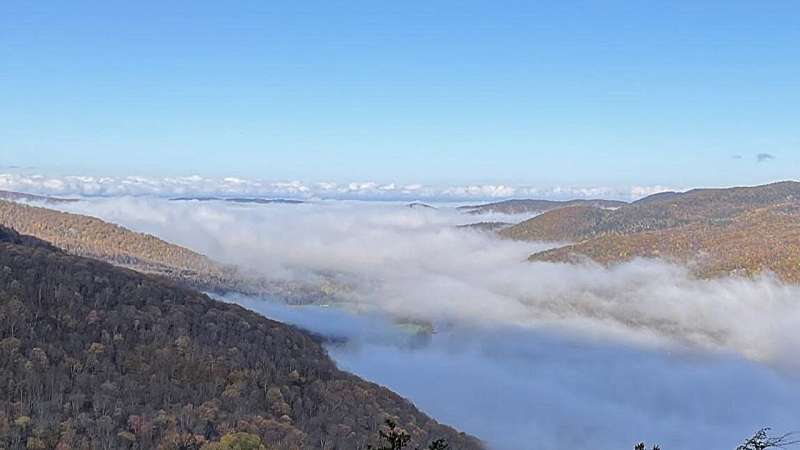
While it’s common knowledge that mountaintops are colder than the valleys below, a new University of Vermont (UVM) study is flipping the script on what we know about forests and climate.
The study, published in Ecology and Evolution, explores forests that experience “cold-air pooling,” a phenomenon where cold air at higher elevations drains down into lower-lying valleys, reversing the expected temperatures—warm at the bottom, cold at the top—that typically occurs in mountainous areas. That is, the air temperature drops with descent from mountain to valley.
“With temperature inversions, we also see vegetation inversions,” says lead study author and former UVM postdoctoral researcher Melissa Pastore. “Instead of finding more cold-preferring species like spruce and fir at high elevations, we found them in lower elevations—just the opposite of what we expect.”
And the effect on these ecosystems is substantial: “This cold-air pooling is fundamentally structuring the forest,” says study co-author and UVM professor Carol Adair.
This insight “can help forest managers prioritize and protect areas with frequent and strong cold-air pooling to preserve cold-loving species as the climate warms,” says Adair.
The researchers looked at three forested sites in New England, ranging from the shallow, crater-like Nulhegan Basin of Vermont’s Northeast Kingdom, to the higher peaks and deeper valleys of the Green Mountains, over two years. They collected data on the types of trees present across elevation transects and monitored temperature hourly.
The researchers found that, far from being the occasional nighttime, seasonal phenomenon it’s historically been thought to be, cold-air pooling happens frequently, year-round, well into daylight hours, Adair says. The phenomenon occurred at every site they studied, but was strongest at the site with the shallowest elevation change.
Refuge in a changing climate
Locations experiencing this phenomenon might prove essential to conservation efforts aimed at preserving cold-adapted species, even as the larger climate warms, Pastore notes. “These cold-air-pooling areas could be valuable targets for small areas that provide a refuge from climate change; they’re areas that might be buffered from, or even decoupled from, climate change, and they’re harboring cold-adapted species that we know are vulnerable.”
She adds that conserving such locations may provide enough time for species to adapt to climate change by either migrating, or by mixing genes with neighbors to assume traits needed for survival in a hotter world.
In this way, Pastore says, “These pockets of cold habitat can act as steppingstones for some species—can buy them that time.”
Conserving such locations may have practical applications, as well, says Adair, “including carbon storage and small-scale recreational opportunities,” adding that cold-loving coniferous tree communities tend to store more carbon than deciduous trees, and forest soils may also hold onto moisture longer—important during periods of extreme rain.
Cold-air pooling has been historically and anecdotally observed elsewhere, Adair says, but this study is the first to quantify it to this degree across many sites beneath the forest canopy, and more research is planned to explore its temporal and geographic extent.
Cold-air pooling is not a panacea, Pastore warns. These forests are “still going to warm—I definitely don’t want to say these are complete safe havens, because climate change will happen there, too—but it might be slower, and maybe species that might otherwise disappear in a warmer climate will remain longer in these locations.”
The research is highly relevant in a changing climate, as ecologists seek to model what may happen to species that require cold conditions. “If you don’t have this process in your model,” Adair says, “you’re going to miss that there are these areas where cold-loving species can persist and are persisting.”
The work has been a hopeful change of pace, Adair says. “I’m excited about the fact that this is good news, in a way. These areas can help cold-adapted species persist.” She adds, “A lot of my research is telling people why bad things are happening, so this is nice. It’s not all good news, but it’s some good news. These places exist. We can use them. They’re important. They’re clearly structuring forests.”
More information:
Melissa A. Pastore et al, Frequent and strong cold‐air pooling drives temperate forest composition, Ecology and Evolution (2024). DOI: 10.1002/ece3.11126
Journal information:Ecology and Evolution
Provided by
University of Vermont

READ MORE
Machine learning can reduce worry about nanoparticles in food
Credit: CC0 Public Domain While crop yield has achieved a substantial boost from nanotechnology in [...]
Final chilling words of Challenger’s crew before their space shuttle exploded 73 seconds into flight
Among the seven crew members who lost their lives to the disastrous explosion was a [...]
Using DNA for tiny tech: Generating DNA origami nanostructures through shape annealing
To tackle nanostructure design, researchers from Carnegie Mellon University are developing automated design tools for [...]
How Do Lava Lamps Work? The Science Behind Liquid Motion
Lava lamps look cool and complicated, but the science behind them isn’t all that complex. [...]
This Next-Generation Bug Spray Could Make You Invisible to Mosquitoes
Perrin Doniger Mosquitoes are utterly, stupendously annoying. They can also carry diseases, such as malaria [...]
New advance in superconductors with ‘twist’ in rhombohedral graphite
Electronic phase separation in multilayer rhombohedral graphite. Credit: The University of Manchester An international research [...]
Top 10 Tips for a Successful Telephone Interview
Having a telephone interview is usually the first base to deciding if a company wants [...]
Mystery solved: The origin of the colors in the first color photographs
Edmond Becquerel, Solar spectra, 1848, photochromatic images, Musée Nicéphore Niépce, Chalon-sur-Saône. A palette of colors [...]